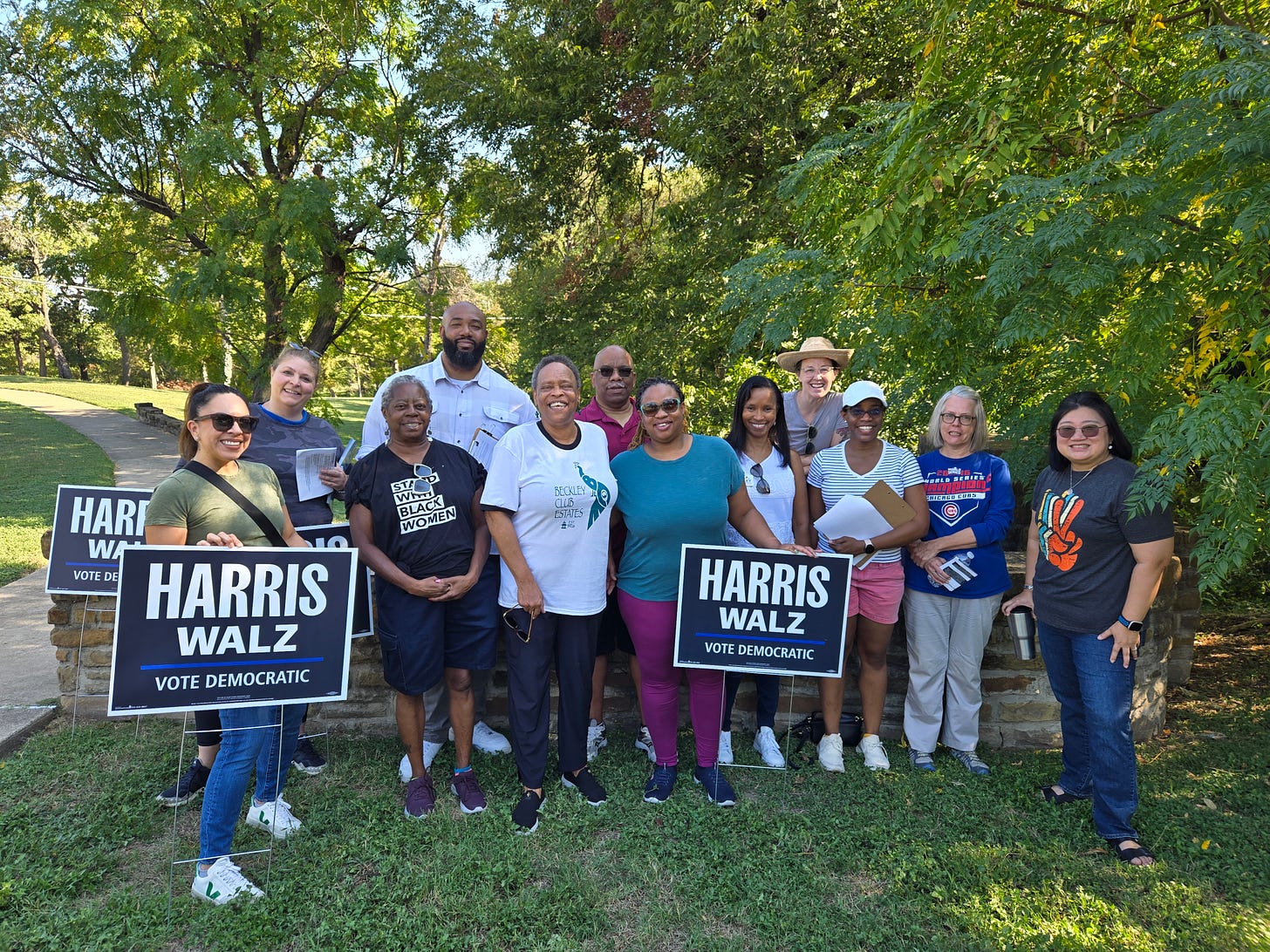Understanding Data: The X Factor in Becoming a Valuable Activist
How knowing the numbers and the people will help make you a better leader
“You want me to do what?”
“I want you to take the eastern quadrant of this map,” I explained to her, pointing to the printout of a map of Dallas County precincts that I had handed her. “Then I want you to enter all the precincts into this Google spreadsheet that I’ve shared with you, look up each one’s precinct chair, and look up all the elected officials who represent each precinct. Then I want you to group these precincts into communities you think make sense. For example, East Dallas, Pleasant Grove, and so on. And don’t forget the suburbs. Thanks so much!”
It was late October 2024, about a week before one of the most consequential presidential elections in American history. I was preparing to end my job as Organizing Manager for the Dallas County Democratic Party, one that saw me in my first full-time political position, managing the organizing activities of Southern Dallas County. As the election slowly neared, however, doubt began overwhelming me. Did I do it right? I would wonder. Part of that uncertainty, though, involved the fact that for almost the entirety of that year, the county party and its funding partner, Texas Majority PAC, had embarked on, in my opinion, an unorganized organizing strategy. From the start, I and the other Organizing Managers were left to essentially figure things out around the county. Perhaps the objective that higher-ups seemed to care most about was whether we hit our weekly metrics: namely, how many doors we knocked on in the sweltering Texas heat and how many hours we spent on the phone cajoling volunteers to knock on doors in the sweltering Texas heat. Initially, I thought that this was just Organizing 101 until, by their own admission, those same higher-ups revealed that voters don’t remember their interaction with you at the door after two weeks. By the end, I had grown worried and confused.
But during the final week of the election cycle, I unexpectedly found myself in a strange lull. By this point, we had shifted most of the remaining blockwalks onto the volunteers who stepped up to lead their own blockwalks and train other volunteers. We had also mailed the tens of thousands of handwritten postcards and letters by our hundreds of volunteers. This free time allowed me to return to one of my favorite hobbies: diving into data. After all, I’m still a tech bro at heart. In my first post, I mentioned that the Democratic Party has fallen behind on messaging and data, and I tackled the messaging issue in my second post. Today, we’ll be discussing data.
As I’ve progressed in this political field, I’ve noticed that not many people know enough about data. That in and of itself does not present a serious problem, as individuals play different roles and should not be expected to do everything. More unfortunate, however, are those who claim the unofficial title of “data geek” but do little more than boast about the quantity of items they deliver, i.e., the number of doors knocked each week or the number of postcards written. Another group thinks of data only when it pertains to volunteer management, accumulating each person’s contact details and when that person can assist in some task. Volunteer management unquestionably plays a crucial role but does not fulfill all the needs of proper organizing. And then there persists those who obsess over a “win number” – the number of votes required for a candidate or issue to win an election – to the point that they abandon a comprehensive organizing game. But frankly, the people who fit into one of these three groups sometimes fit into all of them. So let’s begin by becoming more familiar with the concept of data vis-à-vis politics. Political data essentially should achieve two criteria: 1) it should be any information or statistic that helps an organizing effort, and 2) it should be collected before any organizing effort takes place.
Many tend to believe that data is just numbers, as in how many Democrats live in a particular precinct or by what margin the last Democratic candidate won in some district. Data, however, represents more than that. It also comprises the organizations, clubs, organizers, volunteers, elected officials, candidates, past politicians, neighbors, and generally any person or entity with some sort of stake in your organizing. It’s the number of yard signs in a particular community and the candidates or issues those yard signs tout. It’s the stories of residents fighting a multinational corporation unwilling to close the shingle factory polluting their community. It’s the arcane local laws that help those corporations stay put. It’s the social media posts from activists. And, even though I hate admitting it, data is also the tea spilled about all these people and activities that might inform your method of approaching certain individuals or instances. Real political data is not something that can easily be googled or attained by AI. You cannot expect to helicopter into a locality and proceed with the same cookie-cutter script you used for other localities. That might, from a techie’s perspective, be perceived as efficient, in that you’re painlessly executing a replicable module of work wherever you go, but it falls short on effectiveness. And if you do visit a different area to organize, as I did when I took my duties from Northern Dallas County to Southern Dallas County, make sure you attempt to know those communities.
Now that we have some of the non-numbers stuff out of the way, the fact remains that you still need numbers, and lots of them. That takes us back to the beginning of this post. One day in early October during a blockwalk, I met a volunteer. In the interest of anonymity, let’s call her Elaine. She was a kind, albeit no-nonsense, woman in her 60s whose fire for making the world a better place quietly burns on the inside. I thanked her for knocking on doors and asked if she could lend a hand again. She did and, before I knew it, she became my right-hand woman in the office those last two or so weeks, greeting guests, vacuuming the carpet, and helping haul the tens of thousands of those postcards and letters to the post office for bulk mail. I approached her on this day in late October with an idea. I wanted to map out every community in Dallas County in order to later develop a thorough strategy for how to better organize countywide. “I’ll help you do it,” Elaine agreed, while adding, in her humorous deadpan manner, “but you owe me.”
The first thing I did as part of this endeavor was to print out a map of Dallas County precincts, found on the ArcGIS website. Depending on your county, you may or may not have this resource. ArcGIS doesn’t necessarily have to be the tool you use, but if no precinct map exists for your municipality, you can be the lucky one who creates it.
Next, we grouped the 800+ precincts into a few dozen communities. We then listed each precinct’s precinct chair (found on your local party’s website), city council district and city council member, county commissioner district and county commissioner, state house district and state representative, state senate district and state senator, and congressional district and congressional member. Note that the precinct is our most granular territory. When those in power draw the maps after each census (or whenever they feel like it because they don’t want Democrats to start taking over, as is the case for neighboring Tarrant County and now maybe even the state of Texas), they draw those districts largely based on precincts. This sort of data scaffolding should have served as the base for our organizing efforts in Dallas County.
Finally, after the November election, I gathered numbers from the Dallas County Elections Department website – how many registered voters and ballots cast for each candidate, all grouped by precinct – and inserted each piece of data into the corresponding precinct. From there, I ran wild. Far too much insight that I gleaned from analyzing that data – statistics that would help entities better organize – exists to delve into here, so I’ll probably be saving some of it for future posts. But crunching numbers like this, especially if you’re forming a foundation to continue to build upon, is ideally a team effort that also takes time. Elaine and I spent about three or four weeks building this dataset, which I now use in my consulting services and update after each election. Without her, it would’ve taken much longer.
Ultimately, if I take a step back and attempt to better explain my thesis on organizing at the local level, we should realize that organizing has more to do with leadership than anything else. The simple acts of contacting people in your locality, devising a message based on their input, and constructing an organizing game based on data you’ve collected demonstrates more leadership than that displayed by some people and organizations tasked to win campaigns. If you favor the glory of people seeing you in that light, consider that the good news. The bad news is that those you lead, as well as those observing from the sidelines, will expect much of you, and your reputation might suffer permanent damage with enough wrong missteps. This is the core reason why organizing, whether at the grassroots or the institutional level, proves so challenging: Too few individuals or organizations possess the empathy to see and hear people in their communities, a deep knowledge of numbers, and top-tier communication skills. But if you’re willing to humble yourself, learn, implement, and adapt, there’s no telling what you can do.



